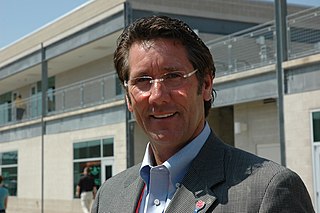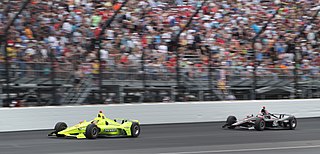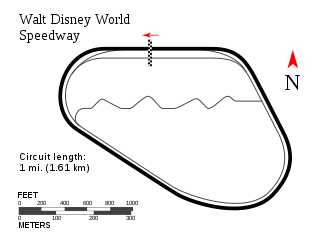
Championship Auto Racing Teams (CART) was a sanctioning body for American open-wheel car racing that operated from 1979 until dissolving after the 2003 season. CART was founded in 1979 by United States Auto Club (USAC) Championship Division team owners who disagreed with the direction and leadership of USAC, with the then-novel idea of team owners sanctioning and promoting their own series collectively instead of relying on a neutral body to do so. Through the 1980s, CART's Indy Car World Series became the pre-eminent open-wheel auto racing series in North America, featuring street circuits, road courses, and oval track racing. CART teams continued to compete at the USAC-sanctioned Indianapolis 500, which was effectively integrated into the series schedule.

Auto Club Speedway was a 2.000 mi (3.219 km), D-shaped oval superspeedway in unincorporated San Bernardino County, California, near Fontana. It hosted National Association for Stock Car Auto Racing (NASCAR) racing annually from 1997 until 2023. It was also previously used for open wheel racing events. The racetrack is located 47 mi (76 km) east of Los Angeles and is near the former locations of Ontario Motor Speedway and Riverside International Raceway. The track is owned and operated by NASCAR. The speedway is served by the nearby Interstates 10 and 15 freeways as well as a Metrolink station located behind the backstretch.

Kentucky Speedway is a now-inactive 1.5-mile (2.4 km) tri-oval speedway in Sparta, Kentucky, which hosted ARCA, NASCAR and Indy Racing League racing from its opening in 2000 until 2011 for IndyCar racing and 2020 for ARCA and NASCAR racing. The track is currently owned and operated by Speedway Motorsports, Inc. Before 2008 Jerry Carroll, along with four other investors, were the majority owners of Kentucky Speedway. Depending on layout and configuration the track facility has a grandstand capacity of 107,000.

Anton Hulman "Tony" George is the former Chairman, President, and CEO of the Indianapolis Motor Speedway and Hulman & Company, serving from 1989 to 2009. He was also formerly on the Board of Directors of both entities. He founded the Indy Racing League and co-owned Vision Racing.

Oval track racing is a form of motorsport that is contested on an oval-shaped race track. An oval track differs from a road course in that the layout resembles an oval with turns in only one direction, and the direction of traffic is almost universally counter-clockwise. Oval tracks are dedicated motorsport circuits, used predominantly in the United States. They often have banked turns and some, despite the name, are not precisely oval, and the shape of the track can vary.

Homestead–Miami Speedway is a motor racing track located in Homestead, Florida. The track, which has several configurations, has promoted several series of racing, including NASCAR, the IndyCar Series, the IMSA SportsCar Championship series, and the Championship Cup Series.

American open-wheel car racing, generally known as Indy car racing, or more formally Indianapolis car racing, is a category of professional automobile racing in the United States. As of 2024, the top-level American open-wheel racing championship is sanctioned by IndyCar. Competitive events for professional-level, open-wheel race cars have been conducted under the auspices of various sanctioning bodies, tracing its roots as far back as 1902. A season-long, points-based, National Championship of drivers has been officially recognized in 1905, 1916, and each year since 1920. As such, for many years, the category of racing was known as Championship car racing. That name has fallen from use, and the term Indy car racing has become the preferred moniker.

Anthony James Renna was an American racing driver who competed in Indy Lights and the Indy Racing League (IRL) from 1998 to 2003. Renna began competitive racing at the age of six, winning 252 races and two national quarter-midget championships before the age of 15. Renna progressed to car racing at 16, competing for three years in the Barber Dodge Pro Series and partnering with stock car driver Jerry Nadeau to finish second for the United States team at the 1996 EFDA Nations Cup. He progressed to Championship Auto Racing Teams' developmental series Indy Lights, winning one race during his three seasons in the championship from 1998 to 2000.

The 1996 Indy Racing League was the first season in the history of the series, which was created and announced on March 11, 1994 by the Indianapolis Motor Speedway, as a supplementary Indy-car series to the established Indy Car World Series sanctioned by Championship Auto Racing Teams (CART) since 1979. It consisted of only three races, as the season concluded with the 80th Indianapolis 500 in May. Walt Disney World Speedway was completed in time to host the first ever event of the Indy Racing League (IRL), and Phoenix International Raceway switched alliances from CART to the IRL, in order to host the second event of the season. At the conclusion of the three-race schedule, Scott Sharp and Buzz Calkins ended up tied for first place in the season championship. With no tiebreaker rule in place, the two drivers were declared co-champions. Its creation, and the opposition of Indy Car's teams and drivers to take part in it, marked the start of 'the Split', a 12-year period of competition between rival series at the top level of American Open Wheel racing that had lasting negative effects in the sport.

The 1996–97 Indy Racing League was the second season contested by the Indy Racing League. Tony Stewart was the champion, while Arie Luyendyk won the Indianapolis 500. The lengthy season was a result of the league abandoning the concept of ending each season with the Indianapolis 500. The 1996–97 season would ultimately consist of the two races that followed the Indy 500 in the calendar year of 1996, and all events contested in the calendar year of 1997. It also saw the introduction of a new chassis and engine package.

The 1999 Pep Boys Indy Racing League was highly competitive and parity was the order of the year. Team Menard had a very good season with their driver Greg Ray capturing 3 race wins and the series championship. This was the last year before CART teams began to break ranks and jump to the IRL.
Michael Dennis Groff is a former race car driver who competed in CART and the IRL IndyCar Series and was the 1989 Indy Lights champion. His younger brother Robbie was also a CART and IRL driver from 1994 to 1998.

Davy Jones is an American racing driver. He won the 1996 24 Hours of Le Mans alongside Alexander Wurz and Manuel Reuter.

Beck Motorsports was a team in the Indy Racing League IndyCar Series owned by Greg Beck. At times in its history the team was partnered with Curb Agajanian Performance Group and 3G Racing owners Stanton Barrett and Steve Sudler.

The 2005 Menards Infiniti Pro Series was the fourth season of the series under the Indy Racing League ownership, and the 20th in Indy NXT combined history, as officially recognized by IndyCar. All teams used Dallara IL-02 chassis and Infiniti engines, a combination that was raced for the first time on road courses.

The IndyCar Series, currently known as the NTT IndyCar Series under sponsorship, is the highest class of American open-wheel car racing in the United States, which has been conducted under the auspices of various sanctioning bodies since 1920 after two initial attempts in 1905 and 1916. The series is self-sanctioned by its parent company, IndyCar, LLC., which began in 1996 as the Indy Racing League (IRL) and was created by then Indianapolis Motor Speedway owner Tony George as a competitor to Championship Auto Racing Teams (CART). In 2008, the IndyCar Series merged with CART's successor, the Champ Car World Series and the history and statistics of both series, as well as those from its predecessors, were unified.

The 1996 Indy 200 at Walt Disney World was the first round of the 1996 Indy Racing League, and the inaugural event for the Indy Racing League, who initiated the American open-wheel split that would last for 12 years. The race was held on January 27, 1996, at the 1.000 mi (1.609 km) Walt Disney World Speedway in Bay Lake, Florida. The race was won by a rookie driver, Buzz Calkins, after leading 130 laps. Future Indy Racing League and NASCAR champion Tony Stewart also made his Indy car debut, finishing second after a late-race duel with Calkins.

The 1997 Indy 200 at Walt Disney World was the third round of the 1996–1997 Indy Racing League. The race was held on January 25, 1997, at the 1.000 mi (1.609 km) Walt Disney World Speedway in Bay Lake, Florida, being the first IRL race of the calendar year 1997. It was the first race with the new chassis from Dallara and G-Force, as well as for the 4000 cc naturally aspirated engines supplied by Oldsmobile and Infiniti, and it marked the first time that a major open-wheel series contested a race with brand-new cars and engines. The race was won by Eddie Cheever after being called off on lap 149 of the scheduled 200 due to heavy rain.

IndyCar, LLC, is a North American auto racing sanctioning body for American open-wheel car racing. The organization sanctions two racing series: the premier IndyCar Series with the Indianapolis 500 as its centerpiece, and the developmental series Indy NXT. IndyCar is recognized as a member organization of the FIA through ACCUS.

The 1998 Indy 200 at Walt Disney World was the first round of the 1998 Indy Racing League season. The race was held on January 24, 1998 at the 1.000 mi (1.609 km) Walt Disney World Speedway in Bay Lake, Florida. As in 1997, rain hampered the event, this time forcing to cancel the qualifying session.


















